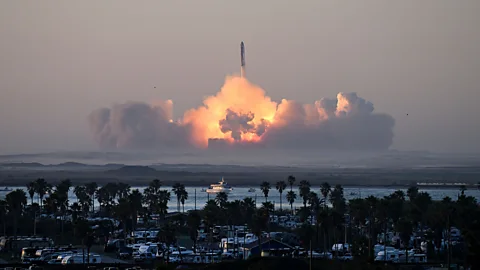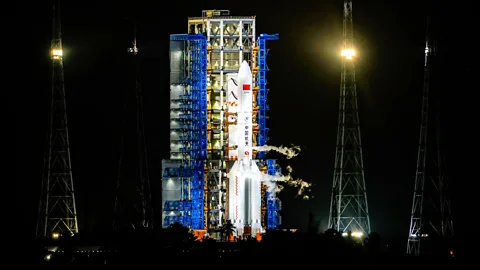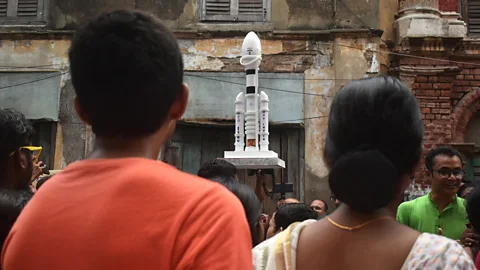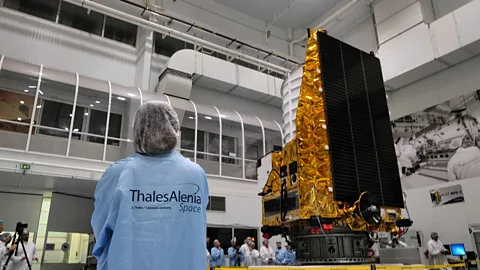Explosions and exploration: Why 2023 was an exciting year in space

 Getty Images
Getty ImagesThe Starship spacecraft's fiery end soon after launch – not once but twice – was a major moment in a year filled with landmark space missions.
"Failure is not an option" was once the most famous phrase uttered in any of the world's mission control rooms. In 2023, it was "rapid unscheduled disassembly" – after Elon Musk's new Starship spacecraft exploded. Twice, as it turned out.
Containing the most powerful rocket ever built, Starship is being developed by Musk's company SpaceX. It stands 121m (397ft) high, 9m (29.5ft) wide and has a total of 39 engines. The two-stage launch vehicle is designed to carry some 150 tonnes, or up to 100 people, into space before returning to Earth. SpaceX plans to use Starship to launch multiple satellites at once, Nasa has commissioned a version of the spacecraft to land astronauts on the Moon, and it may one day carry the first settlers to Mars.
"The idea of a fully reusable launch vehicle is hugely ambitious, and on that scale as well, is just tremendous," says David Wade, underwriter at the Atrium Space Consortium in London, which insures commercial satellites and launchers.
The first Starship launch from Texas in April lasted four minutes before the rocket exploded, showering debris over the Gulf of Mexico and partially destroying the launch pad. Following thousands of modifications, the second flight in November lasted about eight minutes and – despite another "rapid unscheduled disassembly" – SpaceX declared the mission a success. (Find out whether Starship is the loudest space rocket ever launched.)
 Getty Images
Getty Images"Quite frankly, they've gone further than I was expecting on the second flight," says Wade. "They are doing incredibly well."
SpaceX has every reason to be optimistic. When the company was conceived by Musk in the early 2000s it promised to shake-up the rocket business. But the first flight of its Falcon-1 also ended in failure and many people were sceptical of its plans to reuse launchers. Now, 20 years on, some of its rockets have been flown 18 times and SpaceX completely dominates the launcher market and regularly flies astronauts to the International Space Station (ISS) in its Dragon spacecraft.
"Ten years ago this place, the Space Coast, was basically dead and, after the Shuttle retired, well over 10,000 people got laid off," says Ken Kremer, managing editor of the website Space UpClose, who covers launches from Florida. "But in the last four or five years, it's started to rebound and aerospace companies are coming back – it's really a boomtown here right now and that's almost all due to SpaceX."
Today, launches from Cape Canaveral are as frequent as one a week. But despite SpaceX's success and ambition, Kremer is sceptical about Nasa's plans to use Starship as a giant lunar lander.
"It's going to take a tremendous amount of work, it's incredibly complicated," he says. "They will have to land upright or the astronauts will die it if it tumbles over – it's going to take about 16 launches before they can land one Starship on the Moon."
And 51 years after Apollo 17 commander Gene Cernan left the last footprint, the Moon is once again the place to be. What is perhaps surprising is that the most ambitious mission in decades was led, not by the traditional space superpowers, but India. On 23 August, Chandrayann-3 made history when it became the first mission to touch down at the lunar south pole.
"It was a globally significant," says Mila Mitra, former Nasa scientist and Delhi-based co-founder of education company Stem and Space. "Landing at the Moon's south pole was much more difficult because it's got more craters, so India has proved that technology, and it was also able to build this mission at a much-reduced cost."
 Getty Images
Getty ImagesLive coverage of the landing was laden with patriotism, cutting to India's President Narendra Modi waving the nation's flag as the lander touched down. The mission rover even had the Indian space agency's logo and emblem embossed on its six wheels, which left an imprint in the lunar regolith.
The engineers and scientists behind Chandraayn-3 are right to be proud. Despite having only 14 days of power, the rover managed some significant science: finding sulphur, registering a likely moonquake and discovering a temperature difference of around 60C (140F) between the surface and just a few centimetres down.
"This possibly indicates that the topsoil of the Moon may be a very good insulator," says Mitra. "That's promising in terms of finding water underground that might be in the form of ice."
Confirming the presence of readily available ice would enable future missions to use water for survival and to extract oxygen for air and hydrogen for fuel. It's one of the reasons why the lunar south pole is the destination for Nasa's mission to return humans to the Moon, Artemis III. (Read more about the mysteries of the Moon's south pole.)
Unlike the space race of the 1960s, Russia is largely out of the running. Its attempt to beat India to the lunar south pole, Luna 25, crashed into the Moon and its Soyuz spacecraft is a relic from the dawn of the space age. But China is fast catching up with the US. In May, China had six astronauts on board its Tiangong space station (on 30 May, with 11 astronauts on the ISS, there were 17 people in orbit at once – a new record) and it is quietly developing its next generation rockets and spacecraft.
"If [lawmakers] continue to cut Nasa's budget, it is going to delay Project Artemis, it'll delay Starship and the Blue Origin lander too," Kremer warns. "The Chinese could beat us to the Moon, they could beat us to the [lunar] south pole, and that would be really terrible, really terrible."
But while the race to plant the next flag on the Moon heats-up, some questions in space exploration are so fundamental that they cut through geopolitics. Nasa's Osiris-Rex mission, for example, could find clues about the origins of life. The space probe collected samples of rock from asteroid Bennu and, in September, returned a capsule of material to Earth. Scientists hope the 500m-wide (1,650ft) asteroid will provide new insights into the formation of the Solar System some 4.6 billion years ago and possibly even how we got here.
 Getty Images
Getty ImagesWhy visit the 'God of Chaos' asteroid?
During it's close encounter with the Earth in 2029, the asteroid Apophis will be visible with the naked eye in the Eastern Hemisphere. Nasa's Osiris-Rex spacecraft will then spend 18 months alongside the asteroid – which is named after the Egyptian god of Chaos – so scientists can study how the encounter with Earth has changed it. The spacecraft will repeat a dramatic manoeuvre it performed at Bennu - flying within 5m (16ft) of the asteroid's surface and firing its thrusters downwards to stir up rocks and dust on the surface to give a glimpse of what lies beneath.
In the final days of 2023, Nasa announced it is to redirect the Osiris-Rex spacecraft on a new mission to study the asteroid Apophis shortly after the 340m (1,115ft) wide lump of silicate and nickel iron passes within 20,000 miles (32,000km) of the Earth in 2029.
The European Space Agency's Euclid space telescope, meanwhile, is probing the very nature of the Universe. The first images from Euclid were released in November and cover a vast area of the sky in extraordinary detail. But cosmologists using the telescope are less interested in what they can see than what they can't.
Only 5% of the Universe is made of atoms – that's the stuff we can detect. The rest is known as "dark matter" and "dark energy". Dark matter is theorised to be the scaffolding that holds everything in place and dark energy is the mysterious component that drives the expansion of the Universe.
"It's one of the biggest problems in physics," says Isobel Hook, professor of astrophysics at Lancaster University in the north of England. "It's extremely frustrating that we don't know what it is and there's no real convincing theoretical explanation, certainly for dark energy.
"If you just look at the number of people involved in a mission like Euclid, you can see how important it is. There are thousands of people around the world involved in this, wanting to get to the answer."
In April, scientists using the, now dismantled, Atacama Cosmology Telescope in Chile produced a new map of the distribution of dark matter. Over the next six years, Euclid will observe billions of galaxies to build up a map of at least a third of the visible Universe. Although it will not be able to see the missing matter, Euclid can detect its influence by observing how its gravity bends and distorts light, a phenomenon called gravitational lensing.
You might also like:
"For dark matter, it will tell us where it is and map it out," says Hook. "In terms of what dark matter and dark energy are, we'll be narrowing down the possibilities by seeing the effects."
This is the time of year when our thoughts turn to family and friends far away so let's not forget our robot avatars on distant worlds. They include the Curiosity and Perseverance rovers still going strong on Mars, Juno exploring the swirling clouds of Jupiter, Solar Orbiter – blazingly close to our nearest star – and perhaps most important of all, Voyager 1 and 2, limping-on in the void of deep space never to return.
As for 2024, we can look forward to further robotic lunar missions, the launch of Europa Clipper to Jupiter's ice-covered moon and the maiden flight of Europe's (much delayed) new rocket Ariane 6. It should also see the most exciting human space mission in decades: Nasa's Artemis II. The first crewed launch of the SLS rocket and Orion capsule, the Artemis II mission will send four astronauts on a 21-day flight into deep space around the Moon.
If successful, Artemis II will set the stage for the first Moon landing since 1972. But that currently depends on Starship; third time lucky?
--
If you liked this story, sign up for The Essential List newsletter – a handpicked selection of features, videos and can't-miss news delivered to your inbox every Friday.
